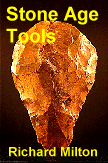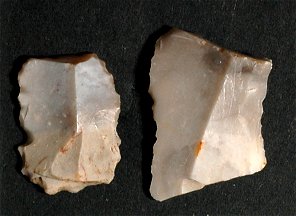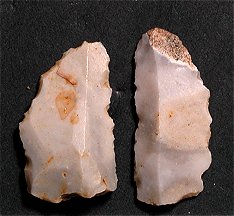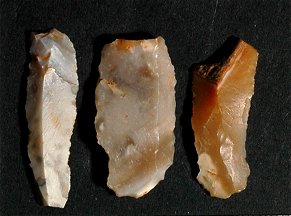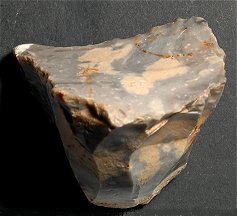|
||||||||||||||||||||||||||||||||||
|
Click Here for
Click
here to read
|
Microlith technology The whole of the Palaeolithic (Old Stone Age) period coincided with the great Pleistocene Ice Age, during which the Northern Hemisphere was largely covered in ice for more than one and a half million years. Early humans visited Northern Europe, the Middle East and China during warmer spells but generally speaking, the nomadic hunters of this age hunted big game and their main lithic technology remained the kind of Acheulian biface core tool illustrated on the book cover at the left. Twelve thousand years ago, the ice age came to an end, and the Mesolithic (Middle Stone Age) began. The glaciers retreated to their present position and sea levels rose around the world. In northern Europe these climatic changes were reflected in dramatic changes of landscape. Forests reappeared in place of the glaciers and arctic tundra . The cold-climate big game such as woolly mammoths were replaced by lighter, fleeter forest dwellers such as roe deer, foxes, and wild boar. Catching such nimble prey meant new methods of hunting and new weapons - arrows and spears. The people of the Mesolithic, still nomadic
hunter-gatherers, responded to these changes by developing new lithic
technologies, chief among which was the microlith - small stone tools,
used to make arrow heads,
spears, and other weapons and tools. Microliths are sometimes
found in large quantites at sites of Mesolithic age. They were fixed to
wooden or bone hafts with resin and possibly twine.
In 2009, Lars Larsson and Arne Sjostrom of the Department of Archaeology and Ancient History of Lund University found a Mesolithic arrow preserved in a peat bog in Sweden. The partly decomposed arrow was reassembled for the photograph above. The microliths are attached to the shaft by resin. (Photo: Arne Sjostrom). There is no universally
accepted definition of the term microlith, especially regarding size. Specialists in lithic technology reserve the term microlith for tools
made in a specific process and with a specific notching and snapping technique.
The stages of this process are illustrated below.
First, the maker strikes a parallel-sided bladelet from a microlith core. Next, he or she creates a small notch near the proximal end of the blade and snaps off the butt. The snapped butt is referred to as a micro burin. Often it is discarded but sometimes it is retouched to be used as a burin or engraving tool. Sometimes, the distal end of the blade is also notched and snapped off and either discarded or retouched for use. The remaining central part of the blade is then retouched in one of a variety of ways to make shapes such as a point, trapezoid etc., as illustrated above. Bladelets intended for microliths are struck from correspondingly small cores - sometimes worked down to amazingly small sizes.
Examples of tools are found in the field with
exceptions to each of the criteria above.
Sometimes microliths are made from blades that do not have parallel sides.
Sometimes only the butt end is snapped off.
Sometimes neither end is snapped off.
Sometimes blades appear to have been utilised without being
retouched. And in some cases either end of a blade may be snapped off,
apparently without creating a preparatory notch. Microliths are often
made from flint or chert, but are also known made from quartz and agate.
Some microliths are unbelievably small and it's difficult to grasp how they were made and what exactly they were used for. All that can be said is that our Mesolithic ancestors were highly successful and the human population grew from less than 100,000 to many millions in only 5,000 years. So their lithic technology was highly successful.
At some major archaeological digs, such as the
Mesolithic site at Starr Carr in Yorkshire, and Horsham in Surrey,
microliths are very common and hundreds or even thousands of
examples have been found. At other sites, few or none are found. There is a distinction recognised by many archaeologists between broad blade
microlith technology associated mainly with the early Mesolithic and
narrow blade
microliths, found mainly at later Mesolithic sites.
The narrow blades are often as little as 4 or 5mm wide, while the
wider blades may be up to 12mm wide. In the United States, microlith technology is sometimes referred to as 'inset technology' (as the micro blades are inset into a wooden shaft). |
|
